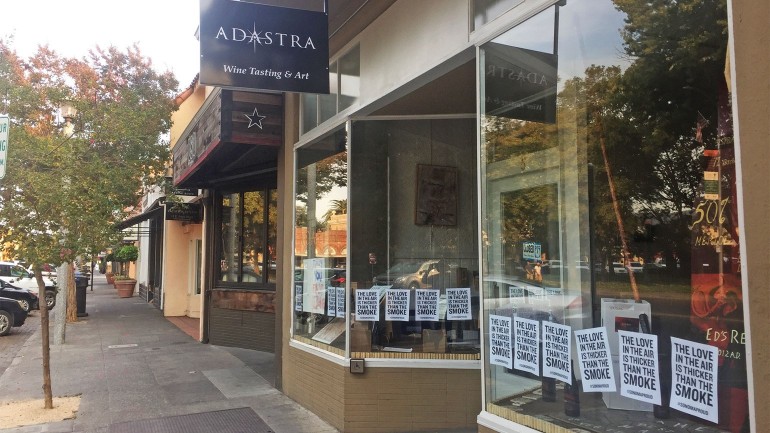Sponsored Listings:
CONCORD, Calif. — As I drove toward wine country, on the same route I had followed countless times before, I was filled with a mix of emotions and questions.
Exactly one week after savage wildfires began claiming lives and land throughout Napa and Sonoma counties, I wondered: How smoky would it be? How much destruction would I find? What would be open and what closed? How hard would it be to get around?
The road-closure maps provided by CalFire and other entities comprised a confusing patchwork of reports, and the lists of which businesses were open and closed were so fluid that I decided to just ignore them and head toward Napa and Sonoma as if this were just one of my regular jaunts. If I ran into roadblocks, I’d improvise.
“Model Bakery is closed,” my husband texted me. He knew my first stop would be Oxbow Public Market in the city of Napa, where I would get a breakfast sandwich at Model and a coffee at Ritual as I planned out my day. I went anyway, and it’s a good thing I did, because Model was open. That pleasant surprise would be the first of many throughout the day.
The first thing I noticed as I got out of my car at Oxbow Public Market was that I didn’t see or smell any smoke. In fact, it had been smokier out in Concord, where I’m based, the week prior than it was last Monday in Napa (though I heard that air quality worsened a bit in Napa the following day and was expected to improve following a much-anticipated light rainfall later in the week).
The market and downtown Napa were quiet. But it was also Monday morning. The city had a very regular workday, low-grade buzz to it. Had I not known about the fires, or were it not for the countless signs and placards sending well wishes to the first responders and firefighters — and the occasional person wearing a face mask — I might not have known anything was awry.
I headed up to Yountville to start checking out some wineries and tasting rooms to see how they were faring. My first stop was Ma(i)sonry Napa Valley, which had opened for the first time since the fires. The stylish tasting room takes reservations and also welcomes walk-ins. Business, not surprisingly, was slow. But the owners were hopeful, because some of their customers were rebooking for the low season winter months. Yountville felt even more subdued and quiet than the city of Napa.
But in Yountville the devastation was much closer. A stone’s throw from downtown, the Atlas Fire had burned more than 50,000 acres of the hills alongside the Silverado Trail, claiming several wineries in the area, including Signorello Estate Vineyards, which was destroyed.
As I headed toward the Silverado Trail, I saw what would be the first of several signs of destruction: the hills charred by the Atlas Fire. As I drove farther north, just as I turned a bend, I gasped. To the west, the hills between Napa and Sonoma were still ablaze as firefighters struggled to contain the Nuns Fire. It finally all started to feel much more real.
As I pulled into the reservation-only Frog’s Leap Winery in Rutherford, I saw that a brave group of wine tasters had gone forward with their appointment, which took place in the winery’s homey but luxurious tasting room against a backdrop of the Nuns Fire. Bookings here, too, had taken a hit.
The group’s driver, Dolly Paez of Allure Limo Wine Tours, was waiting outside in the parking lot. She said the company had already lost $20,000 in business in the week since the fires broke out. She was navigating the patchwork of wineries, finding which were open and which closed, to help clients who were still coming have an enjoyable experience.
“Nobody’s been disappointed,” Paez said.
She added that those wineries in Napa Valley that were open, such as Whitehall Lane, Peju, Prager and Grgich Hills, were really rolling out the welcome mat for whomever came in. That included one winery owner who opened a special bottle of 30-year reserve wine for her clients.

Despite the fires still burning, there were considerably more Napa wineries that were intact than not. Driving through Yountville and St. Helena, Napa Valley still very much felt like Napa Valley, with its picturesque vineyards made all the more lovely by the changing fall colors of the vine leaves.
I asked Paez how to get across to Sonoma. She pointed to the fires and told me I wasn’t going to get through some of the northern back roads that cross the range between Napa and Sonoma. I was going to have to go back south toward the city of Napa and then back up.
As I headed toward Sonoma, the situation definitely felt more severe. It was smokier out this way, and there were immediately more signs of fire-related damage as I drove through the Carneros region that bridges both Napa and Sonoma counties.
I saw a patchwork of burned-down buildings, barns and wineries. The city of Sonoma was a virtual ghost town. Following an evacuation order and loss of power, almost every business on the main square remained closed as of last Monday.
And yet, the spirit of the community was on display. Signs of gratitude and encouragement were everywhere. As of last week, firefighters had gotten the upper hand on all the Napa and Sonoma wildfires. Evacuation orders had been lifted in many areas, including the city of Sonoma, and those places were being repopulated.
It will take some time, and this disaster will remain with the people of Napa and Sonoma and its visitors for years to come. But so much beauty (and great wine!) survived in Northern California’s wine country that I can’t imagine visitors will stay away for long.
Source: travelweekly.com










